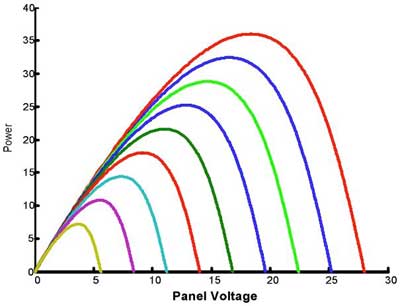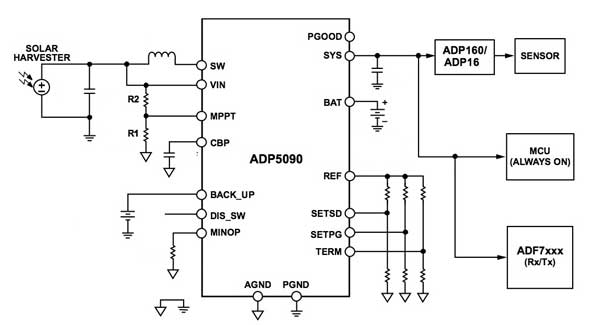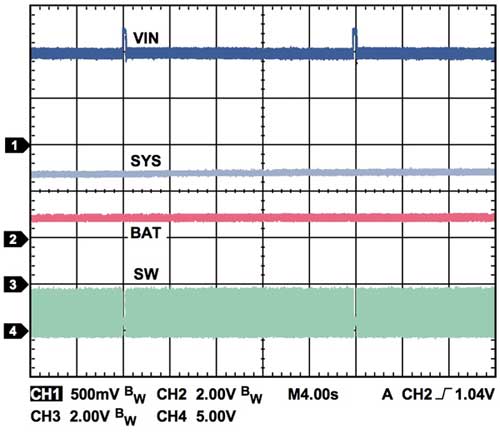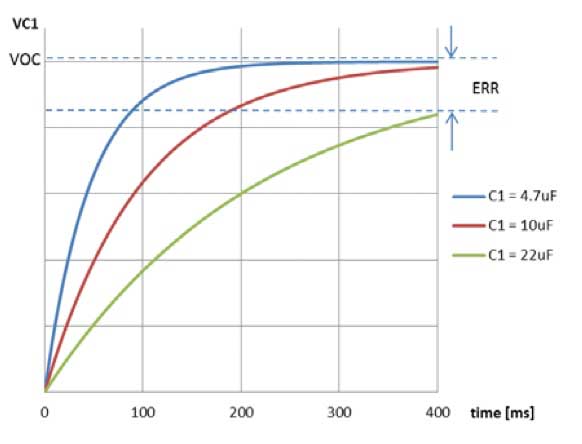Dev Kits Offer Low-risk Entry into Solar-Energy Harvesting
投稿人:电子产品
2016-03-10
Solar-energy harvesting has found support in highly sophisticated devices that integrate a full set of features required to maximize conversion of solar energy to electricity. Engineers can quickly gain a deeper understanding of these devices – and of energy-harvesting principles in general – by taking advantage of low-cost evaluation kits from energy-harvesting IC manufacturers including Analog Devices, Texas Instruments, and STMicroelectronics.
Although the concept of solar-energy harvesting with photovoltaic cells is straightforward, implementation of an efficient energy-harvesting system relies on a solid appreciation of a myriad of details. Among those details, proper loading of the solar PV panel is essential, because the maximum output of a PV panel occurs at a precise point on the PV panel’s power curve. This maximum power point (MPP) can shift across a family of curves associated with a variety of factors including the intensity of the light illuminating the panel, the ambient temperature, the age and health of the PV cells in the panel, and the panel voltage determined by the load on the panel (Figure 1). Accordingly, the most efficient energy-harvesting designs employ maximum-power-point tracking (MPPT) methods, which dynamically adjust the loading on the PV cell to maintain its operation at MPP.

Figure 1: Among various factors affecting solar-energy conversion, the photovoltaic cell or panel voltage determined by the load can dramatically shift the maximum power point. (Courtesy of Texas Instruments)
MPPT optimization methods can be complex – in fact, MPPT algorithms continue to be the subject of research in academia and industry. Nevertheless, specialized energy-harvesting devices such as the Analog Devices ADP5090, STMicroelectronics SPV1050, and Texas Instruments bq25505 offer integrated MPPT capabilities that can meet the needs of many energy-harvesting applications. Although these MPPT-capable ICs simplify implementation of efficient energy-harvesting systems, they themselves are complex devices that require careful attention to details associated with their configuration and operation.
Specialized energy-harvesting devices require few external components to implement a sophisticated solar-energy harvester with MPPT. In fact, the Analog ADP5090, ST SPV1050, and TI bq25505 can be used as energy-harvesting power supplies able to scavenge power from µwatt-level ambient sources, while providing power management to a load and charge management for rechargeable batteries and supercapacitors. For example, with only a few passive components, Analog’s ADP5090 can drive external devices such as MCUs and RF transceivers directly and work with voltage regulators such as the ADI’s ADP161 to power voltage-sensitive devices such as sensors (Figure 2).

Figure 2: Specialized energy-harvesting devices such as the Analog Devices ADP5090 require few external components to deliver a full solar-energy harvesting design complete with MPPT functionality, power management, and battery charging capability. (Courtesy of Analog Devices)
Each of these devices use a similar approach for MPPT that takes advantage of the constant linear relationship between MPP voltage (VMPP) and the open-circuit voltage (VOC) of a solar cell or thermoelectric generator (TEG):
![]()
where the constant k depends on the specific PV cell or panel. Typically, solar cells are at their MPP when loaded to about 70 to 80 percent of their open-circuit voltage and TEGs are at MPP when loaded to about 50 percent VOC. IC manufacturers use this relationship to set VMPP at the appropriate percentage by means of a simple resistor network. For example, the Analog ADP5090 sets VMPP using a pair of resistors R1 and R2 (see Figure 2, above). With this device, VMPP = VOC × R1/(R1+R2), where R2 is the resistor that connects from VIN (VOC) to the ADP5090’s MPPT pin and R1 connects from MPPT to GND in that figure.
During normal operation of the ADP5090, the device stores the VMPP reference voltage sampled at pin MPPT on the capacitor connected to the CBP pin. To ensure that the sampled VMPP is in fact the solar cell’s MPP, the device periodically refreshes the sampled VMPP: Every 19 secs, the ADP5090 disables its integrated boost regulator for 296 ms and resamples the open-circuit voltage, resulting in a periodic spike on VIN (Figure 3).

Figure 3: Operation of MPPT-capable devices such as the Analog Devices ADP5090 can exhibit subtle side effects such as the spike on VIN due to VOC sampling associated with the integrated MPPT algorithm. (Courtesy of Analog Devices)
Although its MPPT sampling characteristics are an important aspect of the ADP5090’s functional capability, MPPT is only one of many. For an engineer looking to employ energy harvesting for charging a battery or otherwise powering a circuit, devices like the ADP5090 includes a complex set of features including boost regulation, charge management, backup power, and a diverse set of signals such as PGOOD for indicating usable power levels, minimum power operating level, and power-source selection, among many others.
The Analog Devices ADP5090-2-EVALZ evaluation kit provides a complete energy-harvesting system that allows engineers to defer a deep understanding of ADP5090 configuration issues and instead focus on its functionality for energy harvesting, battery charging, and power management. In fact, the kit includes the full complement of components shown in Figure 2 (including an ADP161 voltage regulator, but not including an MCU or the ADF7xxx RF transceiver shown in the figure). For example, the kit is fully configured for MPPT, using values of R1 = 18 MΩ and R2 = 4.7 MΩ to provide a setting of VMPP at 80 percent of VOC as required.
For evaluating energy harvesting with its bq25505 device, the Texas Instruments bq25505EVM provides a set of jumpers that allow engineers to easily set the VMPP/VOC ratio to several presets values. Similar to the Analog ADP5090, the TI bq25505 samples VMPP at a fixed ratio of VOC set by a resistor network. In the TI evaluation kit, engineers can use the board’s jumpers to easily set the ratio at 80 percent for solar cells or at 50 percent for TEGs, for example.
Along with the use of proper resistor values for setting the VMPP/VOC ratio, the efficiency of energy conversion also relies on proper selection of capacitors and inductors typically used to boost voltage levels in designs harvesting energy from low-power sources. For boost conversion to operate properly, inductor values must be sufficient to allow at least a 30 percent margin typically above expected peak inductor currents.
Similarly, choice of the input capacitor is critical and improper selection can dramatically impact efficiency. During the 400 ms sampling time used by the STMicroelectronics SPV1050, for example, the input capacitor CIN is charged up to VOC by the energy source with a time constant determined by the capacitance and the equivalent resistance of the source. If the capacitance is too high, the capacitor may not be charged within that 400 ms time window, thus affecting MPPT accuracy and overall conversion efficiency (Figure 4). By using ST’s STEVAL-ISV020V1 evaluation kit, however, engineers are assured of a properly configured SPV1050-based energy-harvesting design capable of optimizing energy extraction from ambient sources.

Figure 4: Proper sizing of resistors, inductors, and capacitors is critical for ensuring maximum energy-harvesting efficiency. Here, choice of an excessively large input capacitor for the ST SPV1050 energy-harvesting IC can result in MPPT errors and loss of efficiency. (Courtesy of STMicroelectronics)
Designed specifically for harvesting energy from solar and other energy sources, specialized devices such as the Analog Devices ADP5090, STMicroelectronics SPV1050, and Texas Instruments bq25505 provide sophisticated capabilities including MPPT optimization, charge management, and backup power features. For designers able to exploit their full functionality, these devices offer significant benefits for creating very sophisticated energy-harvesting applications with few additional components. With the availability of evaluation kits based on these devices, engineers can gain a deeper understanding not only of these devices specifically but also of the principles of energy harvesting in general.
For more information about the parts and dev kits discussed in this article, use the links provided to access product pages on the DigiKey website.
免责声明:各个作者和/或论坛参与者在本网站发表的观点、看法和意见不代表 DigiKey 的观点、看法和意见,也不代表 DigiKey 官方政策。







